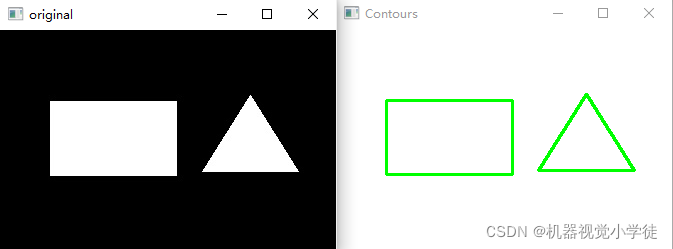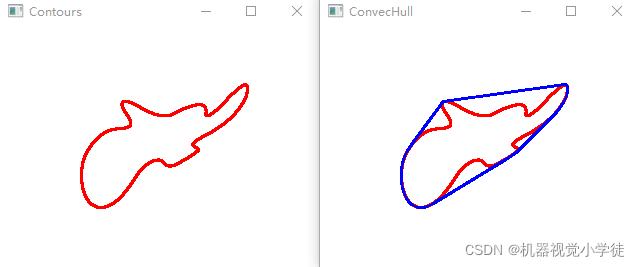OpenCV-Python图像轮廓之轮廓特征详解
图像轮廓是指由位于边缘、连续的、具有相同颜色和强度的点构成的曲线,它可以用于形状分析以及对象检测和识别。本文将带大家详细了解一下图像的轮廓特征,感兴趣的可以学习一下
目录
前言
一、轮廓的矩
二、轮廓的面积
三、轮廓的长度
四、轮廓的近似多边形
五、轮廓的凸包
六、轮廓的直边界矩形
七、轮廓的旋转矩形
八、轮廓的最小外包圆
九、轮廓的拟合椭圆
十、轮廓的拟合直线
十一、轮廓的最小外包三角形
前言
图像轮廓是指由位于边缘、连续的、具有相同颜色和强度的点构成的曲线,它可以用于形状分析以及对象检测和识别。
一、轮廓的矩
轮廓的矩包含了轮廓的各种几何特征,如面积、位置、角度、形状等。cv2.moments()函数用于返回轮廓的矩,其基本格式如下:
1 2 3 4 5 | ret = cv2.moments(array[, binaryImage])ret为返回的轮廓的矩,是一个字典对象, 大多数矩的含义比较抽象, 但其中的零阶矩(m00)表示轮廓的面积array为表示轮廓的数组binaryImage值为True时,会将array对象中的所有非0值设置为1 |
1 2 3 4 5 6 7 8 9 10 11 12 13 14 15 16 17 18 19 20 21 22 23 24 25 26 27 28 29 | import cv2import numpy as npimport matplotlib.pyplot as pltimg = cv2.imread('shape2.jpg')cv2.imshow('original', img)img_gray = cv2.cvtColor(img, cv2.COLOR_BGR2GRAY)ret, thresh = cv2.threshold(img_gray, 125, 255, cv2.THRESH_BINARY)contours, hierarchy = cv2.findContours(thresh, cv2.RETR_TREE, cv2.CHAIN_APPROX_SIMPLE)img1 = np.zeros(img.shape, np.uint8) + 255img1 = cv2.drawContours(img1, contours, -1,(0,255,0),2)cv2.imshow('Contours',img1)m0 = cv2.moments(contours[0])m1 = cv2.moments(contours[1])print('轮廓0的矩:', m0)print('轮廓1的矩:', m1)print('轮廓0的面积:', m0['m00'])print('轮廓1的面积:', m1['m00'])cv2.waitKey(0)cv2.destroyAllWindows() |


二、轮廓的面积
cv2.contourArea()函数用于返回轮廓的面积,其基本格式如下:
1 2 3 4 5 | ret = cv2.contourArea(contour[, oriented])ret为返回的面积contour为轮廓oriented为可选参数, 其参数值为True时, 返回值的正与负表示表示轮廓是顺时针还是逆时针, 参数值为False(默认值)时, 函数返回值为绝对值 |
1 2 3 4 5 6 7 8 9 10 11 12 13 | img = cv2.imread('shape2.jpg')img_gray = cv2.cvtColor(img, cv2.COLOR_BGR2GRAY)ret, thresh = cv2.threshold(img_gray, 125, 255, cv2.THRESH_BINARY)contours, hierarchy = cv2.findContours(thresh, cv2.RETR_TREE, cv2.CHAIN_APPROX_SIMPLE)m0 = cv2.contourArea(contours[0])m1 = cv2.contourArea(contours[1])print('轮廓0的面积:', m0)print('轮廓1的面积:', m1) |

三、轮廓的长度
cv2.arcLength()函数用于返回轮廓的长度,其基本格式如下:
1 2 3 4 5 | ret = cv2.cv2.arcLength(contour, closed)ret为返回的长度contour为轮廓closed为布尔值, 为True时表示轮廓是封闭的 |
1 2 3 4 5 6 7 8 9 10 11 12 13 | img = cv2.imread('shape2.jpg')img_gray = cv2.cvtColor(img, cv2.COLOR_BGR2GRAY)ret, thresh = cv2.threshold(img_gray, 125, 255, cv2.THRESH_BINARY)contours, hierarchy = cv2.findContours(thresh, cv2.RETR_TREE, cv2.CHAIN_APPROX_SIMPLE)m0 = cv2.arcLength(contours[0], True)m1 = cv2.arcLength(contours[1], True)print('轮廓0的长度:', m0)print('轮廓1的长度:', m1) |

四、轮廓的近似多边形
cv2.approxPolyDP()函数用于返回轮廓的近似多边形,其基本格式如下:
1 2 3 4 5 6 | ret = cv2.cv2.arcLength(contour, epsilon, closed)ret为返回的近似多边形contour为轮廓epsilon为精度, 表示近似多边形接近轮廓的最大距离closed为布尔值, 为True时表示轮廓是封闭的 |
1 2 3 4 5 6 7 8 9 10 11 12 13 14 15 16 17 18 19 20 21 22 | img = cv2.imread('shape3.jpg')cv2.imshow('original', img)img_gray = cv2.cvtColor(img, cv2.COLOR_BGR2GRAY)ret, thresh = cv2.threshold(img_gray, 125, 255, cv2.THRESH_BINARY)contours, hierarchy = cv2.findContours(thresh, cv2.RETR_TREE, cv2.CHAIN_APPROX_SIMPLE)img1 = np.zeros(img.shape, np.uint8) + 255img1 = cv2.drawContours(img1, contours, -1, (0,0,255), 2)cv2.imshow('Contours',img1)arcl = cv2.arcLength(contours[0], True)img2 = img1.copy()app = cv2.approxPolyDP(contours[0], arcl*0.05, True)img2 = cv2.drawContours(img2, [app], -1, (255,0,0), 2)cv2.imshow('contours',img2)cv2.waitKey(0)cv2.destroyAllWindows() |

五、轮廓的凸包
cv2.convexHull()函数用于返回轮廓的凸包,其基本格式如下:
1 2 3 4 5 6 | hull = cv2.convexHull(contours[, clockwise[, returnPointss]])hull为返回的凸包, 是一个numpy.ndarray对象, 包含了凸包的关键点contours为轮廓clockwise为方向标记, 为True时, 凸包为顺时针方向, 为False(默认值)时, 凸包为逆时针方向returnPointss为True时(默认值)时, 返回的hull中包含的是凸包关键点的坐标, 为False时, 返回的是凸包关键点在轮廓中的索引 |
1 2 3 4 5 6 7 8 9 10 11 12 13 14 15 16 17 18 19 20 21 22 23 | img = cv2.imread('shape3.jpg')img_gray = cv2.cvtColor(img, cv2.COLOR_BGR2GRAY)ret, thresh = cv2.threshold(img_gray, 125, 255, cv2.THRESH_BINARY)contours, hierarchy = cv2.findContours(thresh, cv2.RETR_TREE, cv2.CHAIN_APPROX_SIMPLE)img1 = np.zeros(img.shape, np.uint8) + 255img1 = cv2.drawContours(img1, contours, -1, (0,0,255), 2)cv2.imshow('Contours',img1)hull = cv2.convexHull(contours[0])print('returnPoints = Treu 时返回的凸包;\n',hull)hull2 = cv2.convexHull(contours[0], returnPoints=False)print('returnPoints = False时返回的凸包;\n',hull2)cv2.polylines(img1, [hull], True, (255,0,0),2)cv2.imshow('ConvecHull',img1)cv2.waitKey(0)cv2.destroyAllWindows() |


六、轮廓的直边界矩形
轮廓的直边界矩形是指可容纳轮廓的矩形,且矩形的两条边必须是平行的,直边界矩形不一定是面积最小的边界矩形。
cv2.boundingRect()函数用于返回轮廓的直边界矩形,其基本格式如下:
1 2 3 4 | ret = cv2.boundingRect(contours)ret为返回的直边界矩形, 它是一个四元组, 其格式为(矩形左上角x坐标, 矩形左上角y坐标, 矩形的宽度, 矩形的高度)contours为用于计算直边界矩形的轮廓 |
1 2 3 4 5 6 7 8 9 10 11 12 13 14 15 16 17 18 19 20 21 22 23 24 25 | img = cv2.imread('shape4.jpg')cv2.imshow('original', img)img_gray = cv2.cvtColor(img, cv2.COLOR_BGR2GRAY)ret, thresh = cv2.threshold(img_gray, 125, 255, cv2.THRESH_BINARY)contours, hierarchy = cv2.findContours(thresh, cv2.RETR_TREE, cv2.CHAIN_APPROX_SIMPLE)img1 = np.zeros(img.shape, np.uint8) + 255img1 = cv2.drawContours(img1, contours, -1, (0,0,255), 2)cv2.imshow('Contours',img1)ret = cv2.boundingRect(contours[0])print('直边界矩形:\n', ret)pt1 = (ret[0], ret[1])pt2 = (ret[0] + ret[2], ret[1] + ret[3])img2 = img1.copy()img2 = cv2.rectangle(img2, pt1, pt2, (255,0,0), 1)cv2.imshow('Rectangle', img2)cv2.waitKey(0)cv2.destroyAllWindows() |


七、轮廓的旋转矩形
轮廓的旋转矩形是指可容纳轮廓的面积最小的矩形。
cv2.minAreaRect()函数用于返回轮廓的旋转矩形,其基本格式如下:
1 2 3 4 | box = cv2.minAreaRect(contour)box为返回的旋转矩阵, 它是一个三元组, 其格式为((矩形中心点x坐标, 矩形中心点y坐标), (矩形的宽度, 矩形的高度), 矩形的旋转角度)contour为用于计算矩形的轮廓 |
cv2.minAreaRect()函数返回的结果不能直接用于绘制旋转矩形,可以使用cv2.boxPoints()函数将其转换为矩形的顶点坐标,其基本格式如下:
1 2 3 4 | points = cv2.boxPoints(box)points为返回的矩形顶点坐标, 坐标数据为浮点数box为cv2.minAreaRect()函数返回的矩形数据 |
1 2 3 4 5 6 7 8 9 10 11 12 13 14 15 16 17 18 19 20 21 22 23 24 | img = cv2.imread('shape4.jpg')cv2.imshow('original', img)img_gray = cv2.cvtColor(img, cv2.COLOR_BGR2GRAY)ret, thresh = cv2.threshold(img_gray, 125, 255, cv2.THRESH_BINARY)contours, hierarchy = cv2.findContours(thresh, cv2.RETR_TREE, cv2.CHAIN_APPROX_SIMPLE)img1 = np.zeros(img.shape, np.uint8) + 255cv2.drawContours(img1, contours, -1, (0,0,255) ,2)cv2.imshow('Contours',img1)# 计算最小旋转矩形ret = cv2.minAreaRect(contours[0])rect = cv2.boxPoints(ret)rect = np.int0(rect)img2 = img1.copy()cv2.drawContours(img2, [rect], 0, (255,0,0), 2)cv2.imshow('Rectangle', img2)cv2.waitKey(0)cv2.destroyAllWindows() |

八、轮廓的最小外包圆
cv2.minEnclosingCircle()函数用于返回可容纳轮廓的最小外包圆,其基本格式如下:
1 2 3 4 5 | center, radius = cv2.minEnclosingCircle(contours)center为圆心radius为半径contours为用于计算最小外包圆的轮廓 |
1 2 3 4 5 6 7 8 9 10 11 12 13 14 15 16 17 18 19 20 21 22 23 24 | img = cv2.imread('shape4.jpg')cv2.imshow('original', img)img_gray = cv2.cvtColor(img, cv2.COLOR_BGR2GRAY)ret, thresh = cv2.threshold(img_gray, 125, 255, cv2.THRESH_BINARY)contours, hierarchy = cv2.findContours(thresh, cv2.RETR_TREE, cv2.CHAIN_APPROX_SIMPLE)img1 = np.zeros(img.shape, np.uint8) + 255cv2.drawContours(img1, contours, -1, (0,0,255) ,2)cv2.imshow('Contours',img1)# 计算最小外包圆(x, y), radius = cv2.minEnclosingCircle(contours[0])center = (int(x),int(y))radius = int(radius)img2 = img1.copy()cv2.circle(img2, center, radius, (255,0,0),2)cv2.imshow('Circle',img2)cv2.waitKey(0)cv2.destroyAllWindows() |

九、轮廓的拟合椭圆
cv2.fitEllipse()函数用于返回轮廓的拟合椭圆,其基本格式如下:
1 2 3 4 | ellipse = cv2.fitEllipse(contours)ellipse为返回的椭圆contours为用于计算拟合椭圆的轮廓 |
1 2 3 4 5 6 7 8 9 10 11 12 13 14 15 16 17 18 19 20 21 22 | img = cv2.imread('shape4.jpg')cv2.imshow('original', img)img_gray = cv2.cvtColor(img, cv2.COLOR_BGR2GRAY)ret, thresh = cv2.threshold(img_gray, 125, 255, cv2.THRESH_BINARY)contours, hierarchy = cv2.findContours(thresh, cv2.RETR_TREE, cv2.CHAIN_APPROX_SIMPLE)img1 = np.zeros(img.shape, np.uint8) + 255cv2.drawContours(img1, contours, -1, (0,0,255) ,2)cv2.imshow('Contours',img1)# 计算拟合椭圆ellipse = cv2.fitEllipse(contours[0])img2 = img1.copy()cv2.ellipse(img2, ellipse, (255,0,0),2)cv2.imshow('Circle',img2)cv2.waitKey(0)cv2.destroyAllWindows() |

十、轮廓的拟合直线
cv2.fitLine()函数用于返回轮廓的拟合直线,其基本格式如下:
1 2 3 4 5 6 7 8 | line = cv2.fitLine(contours, distType, param, reps, aeps)line为返回的拟合直线contours为用于计算拟合直线的轮廓distType为距离参数类型, 决定如何计算拟合直线param为距离参数, 与距离参数类型有关, 其设置为0时, 函数将自动选择最优值reps为计算拟合直线需要的径向精度, 通常设置为0.01aeps为计算拟合直线需要的轴向精度, 通常设置为0.01 |
param距离参数类型:

1 2 3 4 5 6 7 8 9 10 11 12 13 14 15 16 17 18 19 20 21 22 23 24 | img = cv2.imread('shape4.jpg') cv2.imshow('original', img)img_gray = cv2.cvtColor(img, cv2.COLOR_BGR2GRAY)ret, thresh = cv2.threshold(img_gray, 125, 255, cv2.THRESH_BINARY)contours, hierarchy = cv2.findContours(thresh, cv2.RETR_TREE, cv2.CHAIN_APPROX_SIMPLE)img1 = np.zeros(img.shape, np.uint8) + 255 cv2.drawContours(img1, contours, -1, (0,0,255), 2)cv2.imshow('Contours',img1)#计算拟合直线img2 = img1.copy()rows, cols = img.shape[:2][vx, vy, x, y] = cv2.fitLine(contours[0], cv2.DIST_L1, 0, 0.01, 0.01)lefty = int((-x * vy / vx) + y)righty = int(((cols - x) * vy / vx) + y)cv2.line(img2, (0, lefty), (cols-1, righty), (255,0,0), 2) cv2.imshow('FitLine',img2) cv2.waitKey(0)cv2.destroyAllWindows() |

十一、轮廓的最小外包三角形
cv2.minEnclosingTriangle()函数用于返回可容纳轮廓的最小外包三角形,其基本格式如下:
1 2 3 4 5 | retval, triangle = cv2.minEnclosingTriangle(contours)retval为最小外包三角形的面积triangle为最小外包三角形contours为用于计算最小外包三角形的轮廓 |
1 2 3 4 5 6 7 8 9 10 11 12 13 14 15 16 17 18 19 20 21 22 23 | img = cv2.imread('shape4.jpg')cv2.imshow('original', img)img_gray = cv2.cvtColor(img, cv2.COLOR_BGR2GRAY)ret, thresh = cv2.threshold(img_gray, 125, 255, cv2.THRESH_BINARY)contours, hierarchy = cv2.findContours(thresh, cv2.RETR_TREE, cv2.CHAIN_APPROX_SIMPLE)img1 = np.zeros(img.shape, np.uint8) + 255cv2.drawContours(img1, contours, -1, (0,0,255) ,2)cv2.imshow('Contours',img1)# 计算最小外包三角形retval, triangle = cv2.minEnclosingTriangle(contours[0])triangle = np.int0(triangle)img2 = img1.copy()cv2.polylines(img2, [triangle], True, (255,0,0),2)cv2.imshow('Triangle',img2)cv2.waitKey(0)cv2.destroyAllWindows() |

以上就是OpenCV-Python图像轮廓之轮廓特征详解的详细内容
原文链接:https://blog.csdn.net/weixin_43843069/article/details/122039788
伪原创工具 SEO网站优化 https://www.237it.com/

